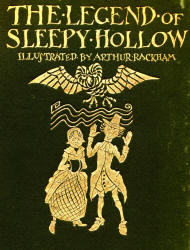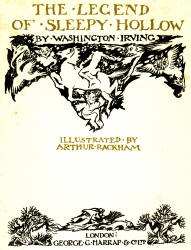"The Legend
of Sleepy Hollow" (1928)
Illustrated by Arthur Rackham
"The Legend of Sleepy Hollow" (1928) is an
illustrated version of Washington Irving's classic early American tale of superstitions and the
mysterious disappearance of Ichabod Crane set after the War of Independence in the Dutch settlement of Tarry Town, New York.
Irving's tale, itself, is believed to be based on an earlier German folk-tale that may have been first recorded by Johann
Karl August Musäus in
his collection of tales entitled Volksmärchen der Deutschen - Musäus' version of
the tales dénoument follows:
The headless horseman was often seen here. An old man
who did not believe in ghosts
told of meeting the headless horseman coming from his
trip into the Hollow. The
horseman made him climb up behind. They rode over
bushes, hills, and swamps. When
they reached the bridge, the horseman suddenly turned
into a skeleton. He threw the old
man into the brook and sprang away over the treetops
with a clap of thunder.
Thematically, Irving's tale is similar to other
traditional poems involving supernatural wild chases, such as Burns' Tam O' Shanter and
Bürger's Der Wilde Jäger.
Rackham's suite of colour and monotone illustrations
accompanying Irving's tale are a lovely example of his matured style and complement
the supernatural themes in
a most thoughtful manner.
As illustrated by Arthur Rackham, the First Edition
of "The Legend of Sleepy Hollow" (1928) included 8 colour plates 30 monotone images
and illustrated end-papers.
 |
On the left, we show a rare copy of
"The Legend of Sleepy Hollow" illustrated by Rackham
and
produced by George G Harrap & Co. Ltd. (London) in 1928.
This example retains the original
decoratively gilt-stamped green cloth cover.
To the right, we show the illustrated
Title Page designed by Rackham.
|
 |
|
.jpg)


%20(sample).jpg)
%20(300).jpg)
.jpg)
.jpg)
.jpg)
.jpg)
.jpg)
.jpg)
.jpg)
.jpg)